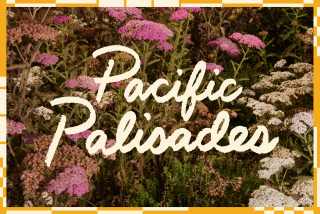Arts & Culture on the Pacific Rim : A SPECIAL REPORT : When Art Breaks Down Nationalism : Culture is the international language
- Share via
I grew up on the Pacific Rim, but for us Australian kids it was just a slice of nature. We loved the high wide skies, and the white sand and crashing waves of the Pacific beaches. The Pacific Rim was not just an economic-political concept for us.
The Japanese bombing of north Australia in 1942 brought home the reality of living on the Rim. For years afterward, fear and racism played a larger role in our perception of the Rim than any cultural interaction with its peoples.
There was an innocence, as well as a narrowness, about Australian life. Later, that strain of innocence helped explain the appeal of some Australian films--such as “My Brilliant Career”--to Americans who see few home-grown films about innocence.
Today, Australia is more cosmopolitan, thanks to diverse immigration. A Melbourne tram is quite likely to be driven by a Vietnamese. A Sydney stockbroker may well be Malaysian. You see restaurant diners dispute the merits of Sichuan and Hunan cuisine as knowledgeably as if arguing about football.
----
Within the Pacific Rim, arts and entertainment are becoming more internationalized. The Australian film-makers go off to Hollywood after doing well with films made in Australia. Just when they have established for the world their Australian-ness, they tend to lose it in the clouds of an international success.
My niece, 23, loves the Australian bush, various Asian cultures, and British and American rock music, and finds no tension in such eclecticism. American movies nearly always interest her more than Australian ones. She goes camping among the wild flowers, then comes back to Melbourne to worship at a Buddhist temple.
American rock music wins the enthusiasm of Australian youth, and counteracts the tinges of political anti-Americanism created by fear that joint U.S.-Australian defense facilities in outback Australia make Australia vulnerable to nuclear attack.
A few years ago, I went to a party in a Melbourne loft for a visiting American entertainer. In a conversational group of young Australians, a lawyer railed against American policies in Central America and on nuclear weapons. He was wearing jeans by an American designer, we were listening to American music, and the guest of honor at the party was an American singer who provoked universal excitement in the loft. Culture seemed to be winning a practical victory over politics.
In the early ‘70s, pop and rock music was self-consciously Australian, with songs like “Down Under” from the group Men at Work, and “Solid Rock,” a hymn to Aboriginal land rights, from the Goanna group.
Today most pubs echo with an amorphous music that transcends any one nation’s spirit. Groups like Midnight Oil play almost metaphysical songs, often with a flavor of resignation that is common to taste in America, Japan and elsewhere.
The appeal of Peter Garrett, lead singer of Midnight Oil, expresses Australia’s coming to terms with racism and its region, as well as the shrinking of the Pacific. I first met him a few years ago at an Aboriginal community in the desert near Alice Springs, where the Oils had arrived for a “Blackfella-Whitefella” music tour. It was the first time a well-known white band had done concerts for black audiences.
Garrett cares about the severe problems of the Aborigines, and about Australia’s relations within the Pacific Rim, especially with Japan. At the same time, Midnight Oil’s current album, “Diesel and Dust” (with an antiwar song like “Put Down That Weapon”), is showing the band’s appeal to young American audiences--helped by college radio.
When you’re accepted internationally, nationalism breaks down; the need to assert nationalism falls away. That’s the trend in much of the Pacific Rim.
----
The Pacific contains a fascinating, formidable slice of humanity, diverse and dynamic. It has not yet cohered into an entity. As it does, arts and entertainment will play a large role in the process.
Kabuki theater from Japan has won admiration for Nipponese culture all over the Pacific Rim, where memories of Japanese war aggression are not quite dead. In reverse direction, Western classical music has been a bridge between the Japanese public and international culture, and the huge and attentive audiences in Japan for symphonic music have enhanced the image of Japan in classical music circles.
In China, they speak with awe of “two Dengs.” One is the top leader Deng Xiaoping, and the other is the brilliant Taipei chantreuse Deng Lijun. The singer, rather than the politician, is the force for peace and unity across the Taiwan Strait. “We used to have to hide her cassettes,” a young professional woman said to me in Peking recently of Miss Deng’s immensely popular romantic Chinese songs. “But now it’s more relaxed--few care what we listen to.”
Today, Taiwan songs, electronics, and even tourists are becoming commonplace on the Chinese mainland. Deng Lijun, and other artists and entertainers, deserve much credit for the new mood of give and take.
Culturally and politically, the Pacific Rim is an extraordinary part of the world. All the world’s major religions are deeply rooted here. Buddhism, Confucianism and Taoism began here; and Indonesia is the largest Moslem nation on earth. The spectrum of ideologies, too, is wider in the Pacific Rim than anywhere. It has seen the world’s classic case of a free market economy--Hong Kong. And the most gruesome case of extremist Marxism--Pol Pot’s Cambodia.
The economies of the Pacific Rim account for 70% of world trade. When I was at college in Melbourne 25 years ago some feared that Southeast Asian countries might fail to resist the Communist threat, turning Australia into the “last domino.” Today some fear that the capitalist economies of Hong Kong, Singapore, Korea and Taiwan might succeed so well that Australia will be left behind as a white backwater in a dynamic “yellow sea.”
As in other parts of the world, the smaller nations of the Pacific Rim are influenced by the larger. American influence tends to be in technology, business management and entertainment. Chinese influence is through the immigration of people (with their culture and cuisine). Japanese influence is through exports and the buying of property.
One cannot say the clearcut trend is Americanization. The interaction in the Pacific Rim is more complex than that. “We are becoming Americanized only in the sense that we’re becoming universalized,” a former cabinet minister in Australia remarked. “It so happens that the U.S. is at the forefront of many things; the whole world is going in that direction.”
So it will continue to be a force for civilization that, in a region where economic levels vary sharply and politics has long pulled people in diverse directions, the arts and entertainment can draw people together.
I possess two “parents”--America and Australia--on either side of the Pacific Rim. Both of them--especialy the West Coast of the United States--will increasingly be social and racial mirrors to the rise, dynamism and stimulating diversity of the Rim.
A couple of years ago, finishing up my work on my book about Australia, I flew out from Melbourne’s bucolic Tullamarine Airport for California. On a perfect morning the 747 swept down into San Francisco. I knew I would miss the sincerity and unpretentious “fair dinkum” character of the Australians. At the same time I felt a ball of satisfaction in my stomach upon regaining a faster lane. I was back in a world more challenging if less comfortable and predictable.
But then the immigrant--in Boston I am that--always loves his new land extravagantly, even as he retains tenacious emotional roots to his land of origin. I love both my parents astride the Pacific Rim, and much else in between as well. No part of the world is on the move so smartly, or with such purpose.
This special report was edited by David Kishiyama, an assistant Calendar editor
More to Read
The biggest entertainment stories
Get our big stories about Hollywood, film, television, music, arts, culture and more right in your inbox as soon as they publish.
You may occasionally receive promotional content from the Los Angeles Times.










